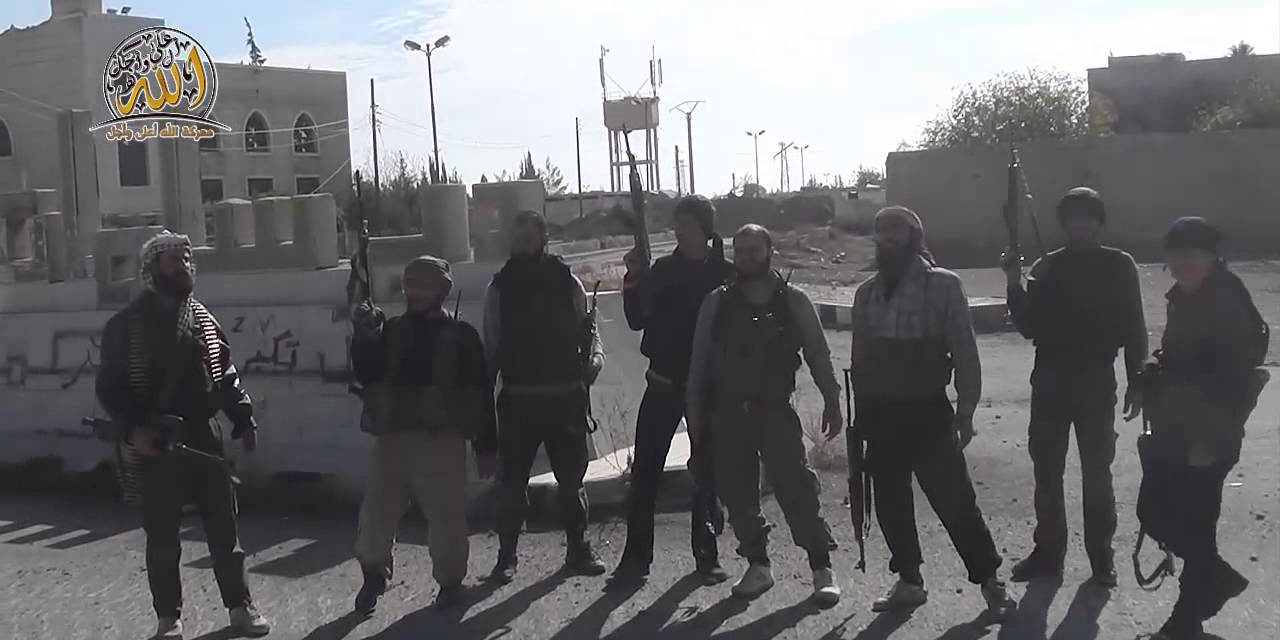PHOTO: Insurgents Celebrate Capture of Deir Salman in East Ghouta Earlier This Month
Last week, insurgents lifted a media blackout to claim victory in Phase 1 of their month-long offensive in East Ghouta near Damascus, seeking to lift the regime’s protracted siege of opposition-held areas.
The fighters declared that they had killed more than 800 pro-regime troops, including more than 200 officers, captured large stocks of weapons and equipment, and taken more than 40 square kilometers of territory. They said that, having broken some of the regime checkpoints enforcing the siege, they had entered Phase 2 of the campaign.
Videos and information from sources supported the claims, including the insurgent capture of two towns and pressure on a third, Otaiba. Further north, opposition fighters were also advancing through the town of Adra.
Unsurprisingly, Syrian State media did not acknowledge the insurgents’ declarations. But how could the regime counter them?
This week, President Assad’s media allies in Iran and Lebanon offered an answer through campaigns declaring that all is well for the Syrian military and very bad for its enemy.
Fars News Agency, the outlet of Iran’s Revolutionary Guards, proclaims that it is Assad forces on the march, “Syrian Army to Open New Fronts in Eastern Ghouta against Militants“:
The Syrian army plans to conduct a series of new military operations and open new fronts in Eastern Ghouta in Damascus countryside, informed sources said on Sunday.
“Since the armed rebel groups who are present in Ghouta have kept calm for the past several months, the army plans to prioritize attention to the crisis in Ghouta and its surroundings as well as control over the armed rebels stationed in these regions once the mop-up operations in Al-Qalmoun region and the battles in Al-Nabek and Deir Al-Attiyeh are complete,” an informed military source, speaking on condition of anonymity, told FNA today.
A bit of a slip-up there, however. Syrian State media declared victory in the regime’s Qalamoun offensive weeks ago, including control of Nabk and Deir Attiyeh. Apparently, however, that is not quite right, since “mop-up operations” are yet to be completed.
Oblivious to this, Fars presses on:
The source noted that Vadi Ain Tarma will be among the first targets of the Syrian army because the militants stationed in this region believe that they are far away and outside the range of the Syrian army’s firepower. Thus, these regions should wait for the upcoming battles and military operations of the Syrian army.
Last month, the Syrian army staged a heavy offensive on rebel positions in the Southern parts of Reef (countryside of) Damascus and took back the towns of Hejeira and Sabina from the militants.
Umm, bit of a geographical problem. Ain Tarma, on the outskirts of Damascus, is several miles west of the insurgents’ battlegrounds in the East Ghouta campaign. And Hejeira and Sabina are to the south of the capital, rather than the east.
To avoid these slips, Lebanon’s Al-Akhbar tries a different approach — it converts the current situation to proclaim that the insurgency has collapsed: “Syria’s Eastern Ghouta: A Chaotic Conflict of Brigades“.
The first part of the article isn’t related to that headline, instead waxing nostalgic aobut “Eastern Ghouta residents [who] primarily work in agriculture and furniture making…mostly peasants living the simple life”.
Eventually, however, it enters a tangled explanation of the insurgency, beginning with the Free Syrian Army and moving to the “seemingly endless” list of brigades now in East Ghouta. There is the criticism of “close ties with Saudi Arabia” and “regional intelligence agencies”. There is a rather strained attempt to link the brigades to even more sinister forces: “The Islamic State of Iraq and Syria (ISIS) has a limited presence in rural Damascus….[but] many incidents may be traced back to the faction.”
Perhaps needless to say, the article’s sketch of a fragmented opposition tries to downplay this autumn’s merger of more than 40 armed groups near Damascus into Jaish al-Islam (the Army of Islam). It ignores completely November’s formation of the Islamic Front — with seven leading factions, including Jaish al-Islam — and its subsequent emergence in the East Ghouta campaign.
But in the end, even the author seems to realise the futility of changing reality, partly acknowledging the developments in the insurgency: “Eastern Ghouta has turned into a stronghold of the Army of Islam.”
And, even though the article fires one more volley — “this army has yet to lift the siege imposed by the Syrian army on Ghouta” — it concludes not with assurance but worry:
The current battles in Ghouta will determine the fate of the Army of Islam, and Ghouta will soon confront two choices: Either the Syrian army turns it into a defense line for Damascus, or Zahran Alloush and his men will turn it into a base for their operations targeting Damascus.

